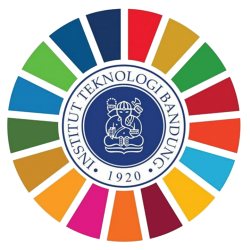SDG-6 Clean Water and Sanitation
Water consumption measurement
ITB measures the total volume of water consumption in whole university area.

Water consumption per person
Volume water:
| Total Water Consumption PDAM 2021 (m3) | 224,460 |
| Total Population (people) | 24765 |
| Water Consumption average (People/m3/year) | 9.06 |
Total population
Student = 21465
Academic Staff & non-Academic Staff = 3300
Total = 24765
Water usage and care
Wastewater treatment
The sewage treatment used is technically for reuse. Domestic wastewater from the buildings is treated by onsite wastewater treatment facilities such as septic tank, biofilter, and johkasou. The treated wastewater is discharged into drainage channel that connected to the retention pond. Part of the water in the retention pond is usually used for agriculture and community usage.

A Johkasou Facility for treating domestic wastewater from buildings in ITB Jatinangor

A Biofilter Facility for treating domestic wastewater from buildings in ITB Jatinangor

A retention pond for collecting storm water and treated wastewater in ITB Jatinangor

A standard septic tank facility in ITB Ganesha
For Laboratories that produce acidic and/or alkaline wastewater, must be processed by neutralization before the treated water is released into the sewerage.

Wastewater treatment for acidic and alkaline wastewater
Preventing water system pollution
Domestic wastewater from the buildings is treated by onsite wastewater treatment facilities such as septic tank, biofilter, and johkasou. The treated wastewater is safely discharged into drainage channel that connected to the retention pond

ITB has a Sewage Treatment Plant (STP) for domestic wastewater

Wastewater treatment for acidic and alkaline wastewater
Free drinking water provided
ITB provided free drinking water by using drinking water fountains. The water quality has been tested by Water Quality Lab, Faculty of Civil and Environmental Engineering, ITB, under test specimen number KA.220/19-1.

Laboratorium result for quality of tested tap water

Information of technology used for tap water, which is use reverse osmosis

Reverse osmosis technology for tap water

Free tap water in ITB
Minimise water usage
Tracking water consumption
Currently ITB is developing a sensor-based measurement system for electricity and water use and an information system (Electricity and Water Energy Management System or Elisa) to track level of water use and avoid excess water use. This Elisa is a research development works by lecturers in Engineering Physics ITB, from measurement that applied already which is Electricity Monitoring system (SiElis) (https://www.youtube.com/watch?v=pc0Wnxh1CrE)

Electricity Monitoring system (SiElis), that will develop into Electricity and Water Energy Management System (Elisa)

Water re-use
Water re-use Policy
ITB apply water reuse policy to minimise water use

ITB Jatinangor masterplan (TBD)
Water re-use application
ITB has water treatment plant of sewage water to be re-used for non-drinking water.


Water treatment plant for sewage water
The Directorate of Facilities and Infrastructure of ITB is creating water reuse from laboratory wastewater which is categorized safe for use as watering plants.

Installation of clean water pipe from water reuse
Water re-use measurement
ITB Water treatment plant is capable to produce 20 liter per second of re-use water.
Plant landscape
ITB has a Campus Masterplan Team, which has an expert in architecture and landscape, where the directorate of facilities and infrastructure (DITSP) regularly consults regarding landscaping which can be more economical in maintenance and avoid the use of excess water.

Invitation for workshop regarding ITB landscape with experts in architecture and landscape

Also ITB has book that contains Masterplan Design for the ITB-Ganesha Campus which focuses on the role and presence of vegetation to create Sustainable Green Campus


Semarak Bunga in Ganesha University Book Contain
Download Semarak Bunga in Ganeha Book
Promoting conscious water usage
ITB promotes conscious water usage to conserve the water consumption. Every water outlets have been put a sign to promote water conservation.

Sign to remind closing the faucet and not to use excessive water
In 2021 ITB issued a circular letter regarding energy and water savings. The letter also explains the steps that can be taken to save water and energy.

Circular letter regarding energy and water saving
Off-campus water conservation support
ITB supports water conservation off campus through community service program. For example:
- ITB held Training Aquaponik to Haurngombong Sumedang resident
- Community Empowerment Through BUMDes for Village Drinking Water Provision (PAMDes) in Pangalengan Village, Bandung Regency
- PPM SITH ITB Saves Sources Of Water In Cisempur Village, Gunung Geulis Forest Area
ITB community service for training and planting 1000 coffee trees to conserve mountain springs
Sustainable water extraction on campus

Rainwater harvesting system in front of Environmental Engineering Building ITB

Rain Water Well (left) and Bioporous hole (right)
ITB Jatinangor campus has implemented water extraction through the construction of two artificial lakes (situ/dam) and the installation of a Water Treatment Plan (WTP). ITB cooperates with the Ministry of Public Works and Public Housing to make this. Furthermore, ITB will make it at the ITB Campus in Cirebon

Water extraction and water treatment plant in ITB Jatinangor
